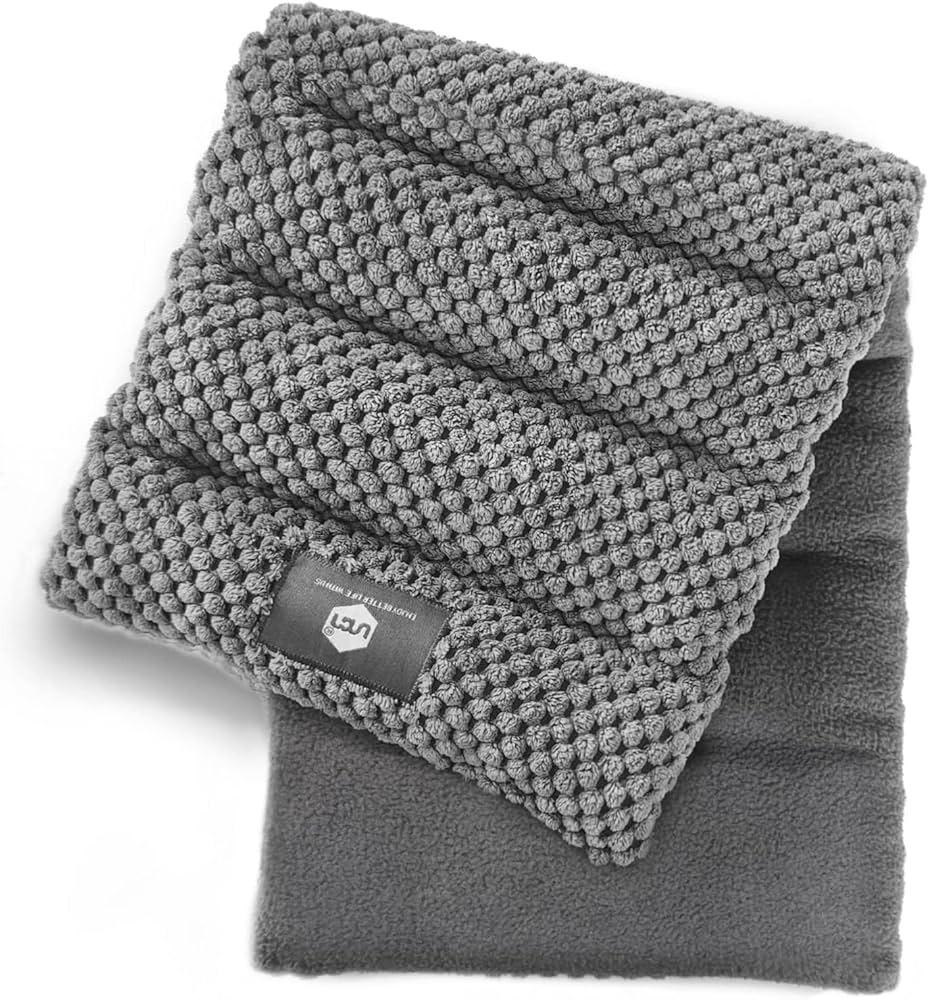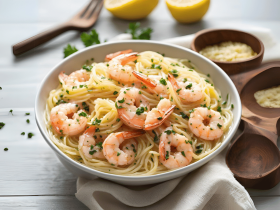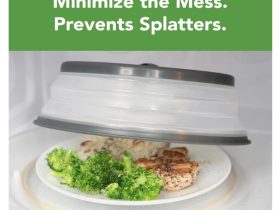Microwave heating pad is a popular choice for those seeking relief from muscle aches, stiffness, or joint pain. Designed for versatility, they come in various shapes and sizes to target different body areas. These pads offer the convenience of quick heating and are often filled with natural materials like rice, flaxseed, or clay beads that retain heat efficiently.
The absence of cords makes them highly portable, allowing users to enjoy the therapeutic benefits of heat therapy without being tethered to an outlet. As a safe and user-friendly option, microwave heating pads have become a go-to solution for at-home heat therapy, promoting relaxation and circulation while being a cost-effective tool for managing pain.

Credit: www.sliceofpiquilts.com
Benefits Of Microwave Heating Pad
Many people use microwave heating pads to feel better. They are great for warming up your body and helping with aches. If you’re wondering how long to microwave heating pad for safe and effective use, following instructions is key. These pads offer many benefits, like easing pain and helping muscles relax. Let’s learn more about how they can help us.
Pain Relief
Microwave Heating Pads are amazing for reducing pain. They work fast to make sore areas feel better.
Here’s why they are good for pain relief:
- Quick to use: You can warm them up in minutes.
- Easy to apply: Just place them where it hurts.
- Safe: They are a safe way to deal with pain without medicine.
These pads can help with different kinds of pain. For example, stomach aches, back pain, or cramps. Many people find them very helpful.
Muscle Relaxation
Muscle tightness can make you feel stiff and uncomfortable. Microwave Heating Pads can help your muscles relax.
This is how they work:
- Warmth: The heat helps blood flow better.
- Comfort: Warmth makes muscles less tight.
- Flexibility: Relaxed muscles move easier and hurt less.
Using these pads after a long day or a workout can be very soothing. They help your body recover and feel ready for the next day. Many people, including athletes, use them to keep their muscles happy.
Types Of Microwave Heating Pad
Many people use microwave heating pads for pain relief. They come in different types. Let’s explore two popular kinds: rice-based and gel packs. Both are easy to use and can provide comfort.
Rice-based
Rice-based microwave heating pads are common and simple. They are small bags filled with rice. You heat them in the microwave to make them warm.
Here is why they are good:
- They hold heat well, releasing it slowly over time.
- You can make them at home with just rice and a sock.
- They mold to your body, which makes them very comfortable.
Rice pads are not just for heat. You can also put them in the freezer. Then, they work like a cold pack. Always check the temperature before you use one. This makes sure it is not too hot or too cold.
Here is a simple table to show how long to heat them:
| Size of Pad | Time in Microwave |
| Small | 1-2 minutes |
| Medium | 2-3 minutes |
| Large | 3-4 minutes |
Gel Packs
Gel packs are another great choice. They are bags filled with a special gel. You can heat them in the microwave.
Here are some of their benefits:
- Gel packs are reusable and last a long time.
- They stay hot or cold for about 30 minutes.
- The gel is soft, so the pack can fit around different body parts.
Some gel packs have a soft cover. This feels nice on the skin. Others might have straps to keep them in place. Remember to wrap gel packs in a towel to protect your skin.
Below is a guide for heating gel packs:
| Weight of Pack | Time in Microwave |
| Light | 30 seconds |
| Medium | 60 seconds |
| Heavy | 90 seconds |
Materials Used
Understanding the materials used in a microwave heating pad is essential. If you’re interested in making your own and wondering how do you make a microwavable heating pad, how to make heat pads for microwave, or how to sew a microwavable heating pad, knowing which materials work best is important.
A good heating pad can provide comfort and relief. They are commonly used for muscle aches and cramps. Choosing the right materials can affect how the pad feels and how long it stays warm.
Fabric Choices
Choosing the correct fabric for a microwave heating pad is crucial. The fabric should be comfortable against the skin and durable enough to withstand heat. It’s important to select a material that’s not only soft but also free of chemicals that can catch fire.
Here are some popular options:
- Cotton: This natural fiber is soft, breathable, and often used for heating pads.
- Flannel: A soft-woven fabric, it provides extra warmth and coziness.
- Fleece: Known for its softness, fleece is also very good at retaining heat.
Users should ensure that the fabric is not too thick. Thick fabrics can block the heat. On the other hand, too thin fabrics may tear or wear out quickly. The best choice is a medium-weight fabric that allows heat to pass through while still being sturdy.
If you’re thinking, can you microwave a towel for a heating pad, it’s possible, but choose a cotton or other microwave-safe fabric, and ensure it’s damp to avoid overheating.
Filling Options
If you’re interested in how to make a microwave heat pad or how to make a microwavable heat pad, it’s important to choose a filling that holds heat well and is safe for microwave use. Many natural materials can hold heat well and are safe choices.
Here are some common fillings:
| Filling Material | Heat Retention | Weight |
|---|---|---|
| Rice | Good | Medium |
| Flaxseed | Very Good | Light |
| Wheat | Good | Heavy |
| Corn | Fair | Medium |
Flaxseed is often favored for its light weight and ability to retain heat. Rice and wheat are also good but may be heavier. Corn can be used but may not hold heat as long. Each material has its own feel and weight, so personal preference plays a big role.
How to Use Effectively
Microwave heating pads are great for easing pain. They are easy and safe to use. This guide helps you use them right.
Heating Instructions
Using a microwave heating pad correctly is important. Here are the steps:
- Check the pad for any damage first. Safety comes first.
- Read the label for specific heating times. Each pad is different.
- Place the pad in the microwave. Make sure it’s flat.
- Heat it for the recommended time. Start with the lowest time.
- Touch it to check its temperature. It should feel warm, not hot.
- Shake or knead the pad. This makes the heat spread evenly.
- If the pad isn’t warm enough, heat it for more seconds. But be careful not to overheat.
Application Techniques
Applying the heating pad correctly can make a big difference. Here’s how:
- Test the temperature on your forearm. Make sure it’s not too hot.
- Place the pad on the area that hurts. You can put it on your back, neck, or shoulders.
- Use a thin cloth between your skin and the pad if needed. This protects your skin.
- Keep it on for 15-20 minutes. This is enough time for it to help.
- Relax while you use the pad. Try to stay still and calm.
Repeat a few times a day if you need. But let your skin rest between uses.
Safety Precautions
Microwave heating pads are popular for easing pain. But, safety is key. Let’s learn how.
Avoiding Burns
Microwave heating pads can get very hot. To stay safe, always check the temperature before using it. Here’s how:
- Heat for short times and check how hot it is.
- Don’t use it directly on your skin. Use a cloth between.
- Shake the pad to spread the heat evenly.
- Never sleep with it on you. This can cause burns.
For kids and those with sensitive skin, extra care is a must. Always have an adult check the heat level.
Storage Tips
Keeping your microwave heating pad safe is important. Follow these tips:
- Keep it dry. Moisture can ruin it.
- Store in a cool, dry place away from pets and sharp objects.
- Don’t fold it. Lay it flat or roll it gently.
- Before use, inspect for damage. Throw away if torn.
The better you care for it, the longer it lasts.
DIY Microwave Heating Pad
If you’re wondering how to make a microwavable heating pad or how to make heat pads for microwave use, crafting your own heating pad can be simple and offer relief from aches. They’re cozy and reusable. This guide shows how to create your own with ease. Craft a personal heating pad for relaxation or as a thoughtful gift.
Materials Needed
Gather these materials to get started:
- Fabric: A piece of cotton or flannel, about 12×24 inches.
- Thread: To sew the fabric edges.
- Needle or Sewing Machine: For stitching the fabric.
- Rice: Uncooked, for the pad filling.
- Funnel: To pour rice into the pad.
- Scissors: To cut the fabric.
- Measuring Tape: For precision in size.
Choose a fabric that feels soft and comfortable. Ensure rice is dry to prevent mold. Now, let’s move on to making your pad.
Step-by-Step Guide
Follow these simple steps to create your heating pad:
- Cut the fabric to the desired size.
- Fold it in half, right sides together.
- Sew along the edges, leaving an opening.
- Turn the fabric right side out.
- Fill with rice using the funnel.
- Sew the opening shut to enclose the rice.
Use small stitches to prevent rice from escaping. Don’t overfill, as the pad should be flexible. Your heating pad is now ready to use. Heat it in the microwave for 1-2 minutes on high. Always check the temperature before use to avoid burns.
Common Issues and Solutions
Microwave heating pads are popular for their comfort and ease of use. They provide heat therapy for sore muscles and aches. Like any product, they can have problems. Here are some ways to fix two common issues: overheating and bad smells.

Credit: www.amazon.com
Alternatives To Microwave Heating Pads
Microwave Heating Pads are popular for their convenience and quick relief. Yet, some people search for different options. This piece explores alternatives like Electric Heating Pads and Hot Water Bottles. Both offer unique benefits for comfort and pain relief.
Electric Heating Pads
Electric Heating Pads are a great choice for those seeking consistent warmth. Unlike microwave options, they maintain a steady temperature. This can be very soothing for muscle aches and stiffness.
Here’s why many prefer them:
- Temperature Control: Users can set their desired warmth level.
- Convenience: No need to reheat, just plug in and use.
- Versatility: Good for various body parts, such as back or shoulders.
These pads come in different sizes and materials. Some are made with soft fabric for extra comfort. Others have features like auto shut-off for safety.
This table compares two popular models:
| Model | Size | Material | Special Feature |
| Pad A | 12×24 inches | Microplush | Moist heat option |
| Pad B | 20×24 inches | Velvet | Auto shut-off |
Hot Water Bottles
Hot Water Bottles are another traditional method for warmth and comfort. They are simple, yet effective.
Here’s what makes them special:
- Portability: Easy to carry around the house or while traveling.
- Eco-friendly: Just need hot water, no electricity.
- Affordability: Generally cheaper than electric options.
People love them for their simplicity and the cozy feeling they provide. They’re also great for pre-warming the bed on cold nights. Like electric pads, they come in various sizes and covers. Some prefer rubber bottles, while others opt for silicone ones. Both materials are durable and safe for use. Covers can be made of soft fabrics like fleece for added comfort.

Credit: www.etsy.com
Frequently Asked Questions
A microwave heating pad is a cushion filled with materials like grains or gels. When microwaved, it retains heat and provides soothing warmth for pain relief or comfort.
Typically, a microwave heating pad should be heated for 1 to 3 minutes. Always follow the manufacturer’s instructions to avoid overheating and potential burns or fires.
Most microwave heating pads come with removable covers that are machine washable. Never wash the inner filling as it may ruin the pad’s heat-retaining properties.
When used correctly, microwave heating pads are safe. Ensure not to overheat, and always check the temperature before applying to your skin to prevent burns.





















Leave a Reply